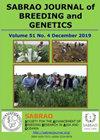用RAPD标记对生长在伊拉克北部的蔷薇属(蔷薇科)进行分子分类
IF 1.7
Q3 PLANT SCIENCES
引用次数: 0
摘要
本研究对来自伊拉克北部不同地区的九种野生玫瑰(Rosa L.)进行了鉴定。这项研究于2021年至2022年在伊拉克摩苏尔摩苏尔大学纯科学教育学院进行。利用随机扩增多态性DNA(RAPD)技术,利用统计程序Numerical Taxonomy and Multivariate Analysis System(NTSYSpc 2.02),确定了物种间的遗传变异关系。RAPD引物共产生523条随机带,使蔷薇品种间的分离成为可能。在所研究的物种中,遗传距离在0.067到1.027之间。遗传维度最小(0.067)的品种为犬蔷薇(Rosa canina var.desgliesei)和犬蔷薇(罗莎canina var.caina),遗传宽度最高的品种为百叶罗莎(Rosa x centifolia)和佛蒂达(Rosa foetida),达1.027。根据遗传距离值,树状图显示了三个主要聚类,第三个聚类分为三个不同的组。RAPD是研究物种亲缘关系的有效方法。本文章由计算机程序翻译,如有差异,请以英文原文为准。
MOLECULAR CLASSIFICATION OF THE GENUS ROSA L. (ROSACEAE) GROWN IN NORTHERN IRAQ BY USING RAPD MARKERS
The presented research, comprising characterization of nine species of the wild rose (Rosa L.), came from various regions of Northern Iraq. The study proceeded in 2021–2022 at the College of Education of Pure Science, University of Mosul, Mosul, Iraq. Employing the random amplification polymorphism DNA (RAPD) helped determine the genetic variation relationships among the species using the statistical program Numerical Taxonomy and Multivariate Analysis System (NTSYSpc 2.02). The use of 10 random primers attained amplifications observed with agarose gel electrophoresis. The RAPD primers generated 523 random bands, making it possible to separate Rosa species from each other. Among the studied species, the genetic distance ranged from 0.067 to 1.027. The least genetic dimension (0.067) came from the species Rosa canina var. deseglisei and Rosa canina var. canina, with the highest genetic breadth reaching 1.027 between Rosa x centifolia and Rosa foetida. The dendrogram revealed three main clusters based on the genetic distance values, with the third one getting split into three distinct groups. RAPD proved as an effective method for studying the relatedness among the species.
求助全文
通过发布文献求助,成功后即可免费获取论文全文。
去求助
来源期刊

Sabrao Journal of Breeding and Genetics
农林科学-奶制品与动物科学
CiteScore
1.90
自引率
50.00%
发文量
63
期刊介绍:
The SABRAO Journal of Breeding and Genetics is an international journal of plant breeding and genetics research and was first published in 1969. It is the official publication of the Society for the Advancement of Breeding Research in Asia and Oceania (SABRAO).
Its objectives are to: promote the international exchange of research information on plant breeding and genetics, by describing new research findings, or ideas of a basic or practical nature; and be a medium for the exchange of ideas and news regarding members of the Society.
The Journal gives priority to articles that are of direct relevance to plant breeders and with emphasis on the Asian region. Invited for publication are research articles, short communications, methods, reviews, commentaries, and opinion articles. Scientific contributions are refereed and edited to international standards.
The journal publishes articles for SABRAO members mainly. The Journal preferred strongly that at least one author should be a current member of the Society. Non-members may also publish in the journal.
 求助内容:
求助内容: 应助结果提醒方式:
应助结果提醒方式:


